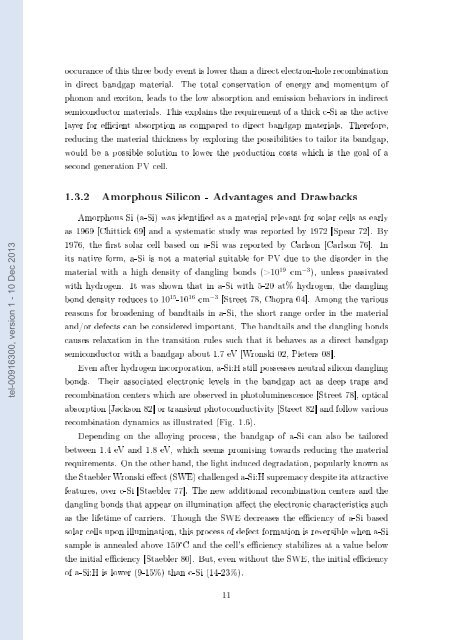Films minces à base de Si nanostructuré pour des cellules ...
Films minces à base de Si nanostructuré pour des cellules ...
Films minces à base de Si nanostructuré pour des cellules ...
You also want an ePaper? Increase the reach of your titles
YUMPU automatically turns print PDFs into web optimized ePapers that Google loves.
occurance of this three body event is lower than a direct electron-hole recombination<br />
in direct bandgap material. The total conservation of energy and momentum of<br />
phonon and exciton, leads to the low absorption and emission behaviors in indirect<br />
semiconductor materials. This explains the requirement of a thick c-<strong>Si</strong> as the active<br />
layer for ecient absorption as compared to direct bandgap materials. Therefore,<br />
reducing the material thickness by exploring the possibilities to tailor its bandgap,<br />
would be a possible solution to lower the production costs which is the goal of a<br />
second generation PV cell.<br />
1.3.2 Amorphous <strong>Si</strong>licon - Advantages and Drawbacks<br />
tel-00916300, version 1 - 10 Dec 2013<br />
Amorphous <strong>Si</strong> (a-<strong>Si</strong>) was i<strong>de</strong>ntied as a material relevant for solar cells as early<br />
as 1969 [Chittick 69] and a systematic study was reported by 1972 [Spear 72]. By<br />
1976, the rst solar cell <strong>base</strong>d on a-<strong>Si</strong> was reported by Carlson [Carlson 76]. In<br />
its native form, a-<strong>Si</strong> is not a material suitable for PV due to the disor<strong>de</strong>r in the<br />
material with a high <strong>de</strong>nsity of dangling bonds (>10 19 cm −3 ), unless passivated<br />
with hydrogen. It was shown that in a-<strong>Si</strong> with 5-20 at% hydrogen, the dangling<br />
bond <strong>de</strong>nsity reduces to 10 15 -10 16 cm −3 [Street 78, Chopra 04]. Among the various<br />
reasons for broa<strong>de</strong>ning of bandtails in a-<strong>Si</strong>, the short range or<strong>de</strong>r in the material<br />
and/or <strong>de</strong>fects can be consi<strong>de</strong>red important. The bandtails and the dangling bonds<br />
causes relaxation in the transition rules such that it behaves as a direct bandgap<br />
semiconductor with a bandgap about 1.7 eV [Wronski 02, Pieters 08].<br />
Even after hydrogen incorporation, a-<strong>Si</strong>:H still possesses neutral silicon dangling<br />
bonds. Their associated electronic levels in the bandgap act as <strong>de</strong>ep traps and<br />
recombination centers which are observed in photoluminescence [Street 78], optical<br />
absorption [Jackson 82] or transient photoconductivity [Street 82] and follow various<br />
recombination dynamics as illustrated (Fig. 1.6).<br />
Depending on the alloying process, the bandgap of a-<strong>Si</strong> can also be tailored<br />
between 1.4 eV and 1.8 eV, which seems promising towards reducing the material<br />
requirements. On the other hand, the light induced <strong>de</strong>gradation, popularly known as<br />
the Staebler Wronski eect (SWE) challenged a-<strong>Si</strong>:H supremacy <strong>de</strong>spite its attractive<br />
features, over c-<strong>Si</strong> [Staebler 77]. The new additional recombination centers and the<br />
dangling bonds that appear on illumination aect the electronic characteristics such<br />
as the lifetime of carriers. Though the SWE <strong>de</strong>creases the eciency of a-<strong>Si</strong> <strong>base</strong>d<br />
solar cells upon illumination, this process of <strong>de</strong>fect formation is reversible when a-<strong>Si</strong><br />
sample is annealed above 150°C and the cell's eciency stabilizes at a value below<br />
the initial eciency [Staebler 80]. But, even without the SWE, the initial eciency<br />
of a-<strong>Si</strong>:H is lower (9-15%) than c-<strong>Si</strong> (14-23%).<br />
11
















